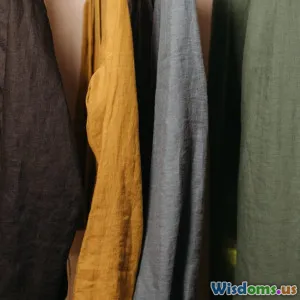
From Ocean Plastic to Runway Dress Real Stories of Circular Fashion
9 min read Explore how ocean plastics transform into stunning runway dresses, showcasing inspiring circular fashion stories. (0 Reviews)
From Ocean Plastic to Runway Dress: Real Stories of Circular Fashion
Introduction
Imagine a garment that doesn't just dazzle on the runway but tells a story of transformation — from trash found drifting in the ocean to a stunning showcase of sustainability and style. This is the emerging reality in the world of circular fashion, where designers, scientists, and environmentalists collaborate to transform ocean plastic waste into runway-ready couture. The shift towards circular fashion is more than a trend; it’s a necessary response to the global plastic pollution crisis, which threatens marine habitats and human health. According to a study published in Science Advances, over 8 million tons of plastic enter the oceans each year, making up 80% of marine debris.
In this article, we'll explore real, inspiring stories of how discarded ocean plastics are being reinvented into fashion statements, shining a light on innovations shaping an industry striving to close the loop on waste.
Understanding Circular Fashion: More than Greenwashing
Circular fashion is a design philosophy focused on creating systems that eliminate waste by keeping garments and materials in continuous use. Unlike the traditional linear model of take-make-dispose, circular fashion promotes recycling, upcycling, and regeneration.
Ocean plastics—often nylon and PET derived from the countless bottles and fishing nets lost at sea—have emerged as a prime resource in this movement. Collecting discarded plastic is the first step, but the transformation journey requires chemistry, engineering, and creativity.
As Dyson award-winning designer Matthew James notes, “Circular fashion challenges us to rethink everything from textile sourcing to end of life. Turning ocean plastic into fiber pushes boundaries of sustainability, style, and practicality.”
Journey from Ocean Pollution to Textile Fiber
1. Collection and Cleaning
Ocean plastic is formidable to collect—floating vast distances and often mingled with organic materials. Organizations such as The Ocean Cleanup and Parley for the Oceans orchestrate retrieval projects, gathering marine debris while promoting community engagement.
One example: Parley’s AIR program collaborators surface plastic debris before it breaks down into microplastics. These plastics undergo rigorous cleaning to remove salt, sand, and biological remnants.
2. Recycling into Resins and Fibers
After cleaning, plastics are shredded and heated into pellets. The conversion technologies transform these pellets into yarns and fibers. A leading innovator in this field, Finnish company ECONYL®, specializes in regenerating nylon waste—including fishing nets—into fresh textile fiber for high-performance apparel.
ECONYL® fibers provide identical quality to virgin nylon, which major brands such as Stella McCartney and Adidas trust for their sustainable collections.
Case Studies: Ocean Plastic Runway Dresses Making Waves
Stella McCartney’s Prêt-à-Porter Ocean Series
In 2019, Stella McCartney’s collaboration with Adidas led to the creation of a collection made predominantly from ECONYL®, diverting discarded nylon from oceans and landfills. The brand’s distinctive statement dresses combined luxury aesthetics with eco-conscious purpose. This highlighted that sustainability can coexist with high fashion.
Marine Plastic Couture by Christopher Raeburn
British designer Christopher Raeburn turns ocean plastic waste into seasonal collections, redefining upcycling. His “Re-Made” capsule collections often include dresses and jackets constructed from recycled nets and plastic collected from the Pacific Ocean. Raeburn advocates, “Creative reuse is a revolution in fashion — we have a responsibility to innovate designs that actively restore and protect the planet.”
Runway Statement: Rebecca Ellen’s Pollution Dress
In 2018, artist and designer Rebecca Ellen made headlines with her dress created entirely from plastic waste collected on UK beaches. The dress was both a protest and a beacon of circular fashion’s possibilities, inviting dialogue on pollution and consumer responsibility.
Impact Beyond Fashion: Environmental and Social Benefits
-
Reducing Ocean Pollution: Transforming waste into high-value products motivates collection efforts, keeping plastics out of sensitive marine ecosystems.
-
Economic Opportunities: Companies in circular fashion create jobs in waste collection, processing, and design sectors, often involving coastal community members who face economic vulnerabilities.
-
Consumer Awareness: Runway models showcasing ocean plastic garments prompt discussions about sustainable consumption. As noted by sustainability expert Kate Fletcher, “When design communicates a story—especially of transformation—it empowers consumers to engage consciously.”
Challenges and Future Prospects
Despite promising progress, hurdles remain:
-
Scalability: The current supply of ocean plastics cannot fully satisfy global textile demands, but innovations in synthetic fiber recycling continue evolving.
-
Collection Difficulties: Ocean plastic retrieval is labor-intensive and weather-dependent. Satellite and drone technologies are being tested to improve tracking and efficiency.
-
Price Barrier: Products using recycled ocean plastics can cost more due to complicated processing, limiting accessibility for broader markets.
Looking ahead, combining circular fashion with biodegradable textiles, blockchain transparency, and localized manufacturing could help scale sustainable solutions.
The fashion industry already contributes 10% of global carbon emissions; hence circular solutions tied to ocean plastics are a starting point reflecting wider systemic change.
Conclusion
The voyage from ocean plastic waste to couture runway dress portrays more than a technical marvel; it reveals the potential to reconcile human creativity with ecological healing. By repurposing what was considered refuse into symbols of style and sustainability, designers and innovators spotlight how circular fashion can play a pivotal role in confronting the plastic pollution menace.
As consumers grow increasingly conscious, the demand for transparent, impactful sustainability intensifies, proving eco-fashion is here to stay. The extraordinary stories of circularity suggest that fashion's future is not just beautiful fabric but the embodiment of hope and innovation.
In advocating for the planet, every stitch tells a story — from ocean depths to dazzling catwalks, proving that real change is not just possible, but wearable.
References:
- Jambeck, J. R., et al. (2015). Plastic waste inputs from land into the ocean. Science, 347(6223), 768–771.
- The Ocean Cleanup. (n.d.). Retrieved from https://theoceancleanup.com/
- Parley for the Oceans. (n.d.). Retrieved from https://parley.tv/
- ECONYL®. (n.d.). Regenerated Nylon. Retrieved from https://www.econyl.com/
- Fletcher, K. (2014). Sustainable Fashion and Textiles: Design Journeys. Routledge.
Author’s Note: This piece aims to illuminate that sustainable innovations aren’t confined to labs or environmental reports but bloom vibrantly on runways worldwide. The merging of ocean guardianship with fashion artistry showcases conscious industries' power to redefine our cultural and ecological storylines.
Rate the Post
User Reviews
Popular Posts




















